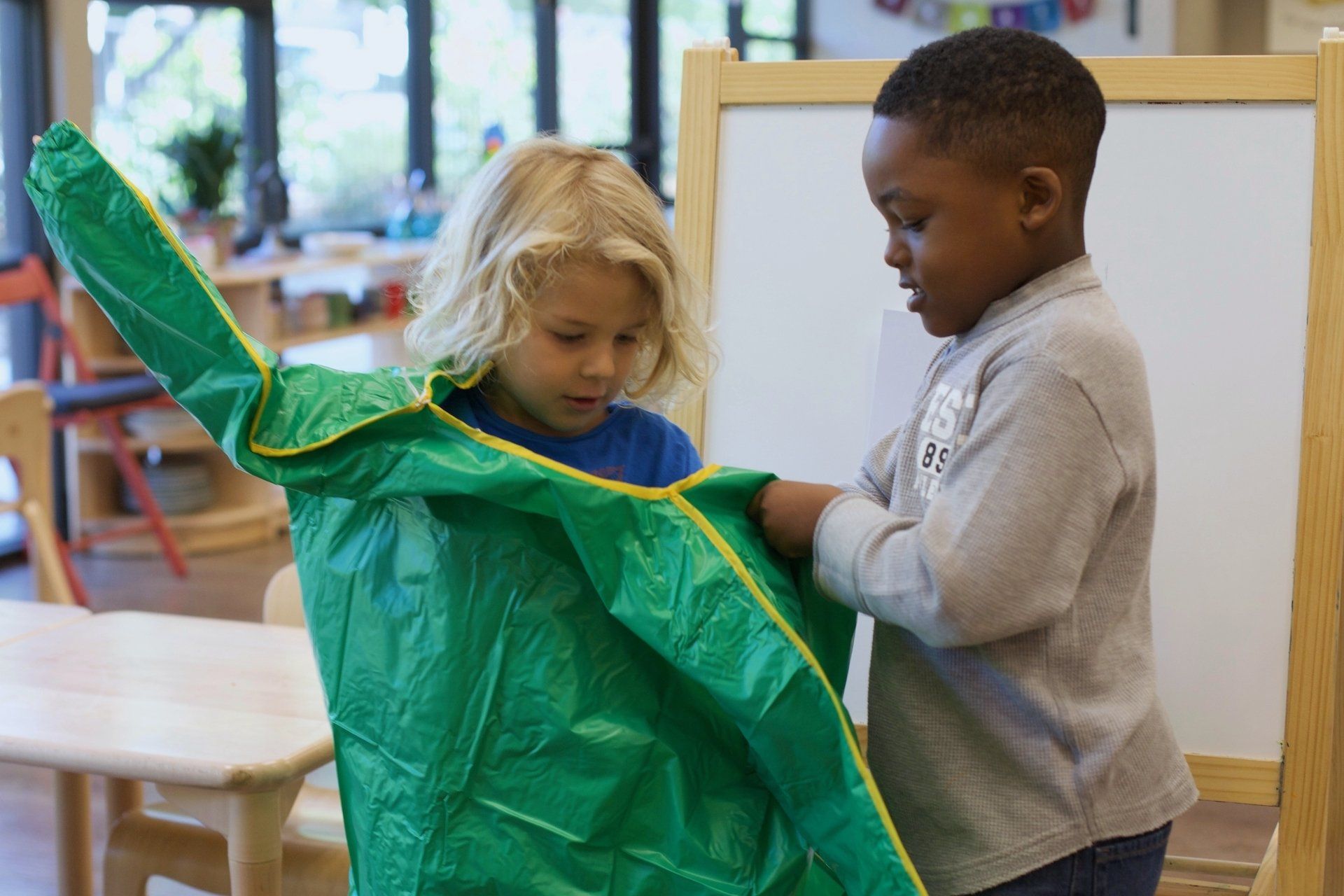Blog Layout
Books to Read Before Family Movie Night
Dec 27, 2020
There are SO many incredible pieces of children’s literature that have eventually been made into movies. In this article, we’d like to share just a few of our favorites. With a bit of extra time at home together, you might enjoy reading one of these books together, then watching the movie. Children love noticing the similarities and differences, plus doing so is great for building reading comprehension skills.
Enjoy!
The Polar Express
by Chris Van Allsburg
The classic Christmas tale is appealing to both children and adults. It’s hard to tell which is more magical - the story of a boy’s journey to the North Pole or the stunningly gorgeous illustrations. So many movies stray noticeably far from their original book inspiration, but this one does not. The movie evokes the same feel of the book’s plot and artwork.
Shrek!
by William Steig
Many of us are familiar with the animated classic, but did you know that Shrek! originated as a hilariously disgusting children’s book? Shrek reaches an age at which his parents decide to kick him out of their swamp and out on his own. Shrek prides himself on his repulsiveness, and after meeting a fortune-telling witch on his journey, he sets out on a mission to find his princess.
Where the Wild Things Are
by Maurice Sendak
Max, like most children, is replete with mischief. Unfortunately, one evening, his mother has had enough of his antics and sends him to bed with no supper. Whether Max slips into a dream or sets out on a journey is left for readers to wonder, but his travels take him across vast oceans to a land of mysterious beasts, of which he becomes the leader.
The BFG
by Roald Dahl, illustrated by Quentin Blake
One evening Sophie peeks out her bedroom window, only to see a large creature. When the creature sees her, he packs her up with his things and takes her away to his distant home. Luckily, for Sophie, the creature is the BFG, or the Big Friendly Giant. They become fast friends on a mission to save the world from the other giants, who are even bigger and not the least bit friendly.
The Ramona series
by Beverly Cleary
Children have loved this relatable series for generations. Romana and her big sister Beezus, their cat Picky-Picky, and their parents live on Klickitat Street. The books explore all sorts of phases and situations children understand, including sibling relationships, friendships, starting at a new school, negotiating with parents, having to spend time with a babysitter, mischief caused by pets, preparing for a new baby, and so much more.
Because of Winn Dixie
by Kate DiCamillo
Young Opal is new in town, and she and her father the preacher are all alone. Opal thinks about her mother, who left when she was three years old, and wishes she knew more about her. One day, while Opal was in the Winn Dixie grocery store, a stray dog snuck in and began running around the produce aisle. It was on that day Opal claimed him as her own, named him Winn Dixie, brought him home for a bath, and her life began to change.
Charlotte’s Web
by E.B. White
Fern, a precocious child, begs and pleads with her father in an attempt to save the life of a young runt pig. Her father capitulates, and Fern cares for the growing pig (Wilbur) until he is too large and is sent to live at her uncle’s nearby farm. It is here that Wilbur meets a new friend - a spider named Charlotte. After learning about Wilbur’s unfortunate probable fate, he and Charlotte work together in an attempt to save him, securing his safety and cementing their friendship.
The Witches
by Roald Dahl, illustrated by Quentin Blake
A young boy and his grandmother take a vacation together, during which they find themselves inadvertently amongst a convention of witches. Witches, in Dahl’s tale, look very much like ordinary women, but after a childhood mishap, the grandmother knows exactly how to spot one. She teaches her grandson all she knows, and the two work together in hopes of protecting children everywhere.
Bridge to Terabithia
by Katherine Paterson
Be warned: this book is beautifully written, but terribly sad. Jesse and Leslie are both in need of a friend. They’re neighbors, the same age, and seem to have a lot in common - even when they don’t. Near the creek by their homes they create an imaginary world that they both retreat to as often as possible. Their friendship grows, and Jesse’s life changes for the better. One day when Jesse is away, he returns to discover a horrible tragedy.
The Hobbit
by J.R.R. Tolkien
Bilbo Baggins is a hobbit; and imaginary creature of Tolkien’s creation. This is a story of an epic journey which Baggins takes in hopes of winning a share of a treasure guarded by a dragon. Throughout his journey, he grows as a character in various ways. Another well-known book and sequel to The Hobbit is The Lord of the Rings.
You might also like

19 Sep, 2022
Adolescents exist between two worlds: they are no longer children but they aren’t yet adults. On this bridge to adulthood, adolescents need opportunities to develop real, meaningful, adult-level skills. They aspire to do what adults do. They are curious about how to make their own way in the adult world. As adults, we are part of an economic system. Even if we aren't using money to buy something, through our work or our hobbies we produce or consume aspects of culture. In this way, economics is about the web of interdependence we have with other people. We all depend upon the work and activity of others. Economics and Interactions If we look at economics as how people offer value in their interactions, as well as the production, distribution, and consumption of services and goods, we can really think about economics as how we organize ourselves in society. Because adolescents are building the skills for stepping into the adult world, it’s important to consider how they are developing their ability to navigate this economic aspect of adult life. How many of us had the opportunity, as adolescents, to develop the skills necessary for economic independence? How would our lives be different if, as adolescents, we had a support system so we could Oigure out a fair and reasonable cost for goods we produced, faced the reality of a proOit and loss statement, or found our way in navigating the paths of spending, saving, and sharing? Road to Achieving Economic Independence Dr. Maria Montessori realized the importance of adolescents developing these kinds of skills. In From Childhood to Adolescence, Dr. Montessori made a bold statement about our approach to education and its impact on the greater society. She stated it clearly: “The essential reform is this: to put the adolescent on the road to achieving economic independence.” So in Montessori adolescent programs, we offer our emerging young adults the opportunity to learn key skills of production and exchange. We sometimes call this “microeconomy.” The basic idea is that adolescents need opportunities to produce goods and services, and work with money and monetary systems, so they can develop an understanding and appreciation for how economies work and their own role in economic systems. Real, Meaningful, and Purposeful Work This experience can take many different forms depending upon the community. Whether running a farm stand or a holiday marketplace, adolescents get to learn key skills. They learn to balance proOit and loss. They discuss and determine how much money should be reinvested into the business to help it grow or how much money should be reinvested in the greater community. They respectfully listen to their customers’ needs and concerns and incorporate that feedback in useful ways. In order to have these learning experiences, adolescents need real, meaningful, and purposeful work. Just like young children need to actually prepare food rather than play with a pretend kitchen set, adolescents need actual experiences in creating a business plan, keeping track of income on a spreadsheet, and balancing a budget. They need to practice accounting work so they can build the skills for their own economic independence. They need to have the thrill of handfuls of cash and then face the responsibility of keeping track of those earnings. They need the experience of paying for replacement materials when they have overused key supplies. If they have developed some savings and want to invest the money, they need to Oind opportunities that align with their values. Preparing for Adult Life Too many of our young people enter the world of adult lives without having experienced their role in an economy (perhaps other than being consumers!). Economic independence is a key part of preparing for adult life. We want our adolescents to step into maturity with conOidence that they can independently navigate their new responsibilities and roles. If we give adolescents the opportunity to learn how to have a sound basis for their economic decisions, imagine where they will be when they are adults and making decisions that affect broader aspects of society!

12 Sep, 2022
In their first weeks of life, babies begin to focus their eyes and track objects. These small acts of visual control provide an important foundation for newborns who are building their neural networks. To set infants up for success, we offer a series of specially designed mobiles to aid this development. Each Montessori mobile is created with particular characteristics to help babies further develop their sense of sight, depth perception, concentration, hand-eye coordination, and more. Plus, newborns love them! Essential Characteristics of Montessori Mobiles Montessori mobiles follow a progression that parallels infant development. The first mobiles have a visual focus and begin with basic shapes. They progress to include more complicated objects and eventually become interactive and tactile. The first mobiles are simple and light enough to allow them to flow with gentle air currents. In order for infants to have the best visual experience, a mobile should be hung so that it is about 12 inches in front of them rather than directly above. When babies are lying on their back, there should be a visual line at about a 45-degree angle from their eyes to the mobile. This particular placement allows infants to see the whole mobile moving. Each mobile has visual components designed to help infants track the objects and sharpen their vision. Then after these opportunities to follow objects visually, infants begin to have more arm and hand control and might begin to reach and grasp objects nearby. To support this new ability to reach and grasp, the mobiles take a slightly different form and thus need to be easy to grasp, colorful, and safe for children to mouth. Progression of Mobiles: Visual The first four mobiles–the Munari, Octahedron, the Gobbi, and the Dancers–provide babies with meaningful visual experiences when they are just recognizing shapes and then later identifying colors.

05 Sep, 2022
In Montessori, we talk a lot about independence. However, one of the lesser known or understood aspects of Montessori is that independence isn’t the end goal. As humans, we are each wonderful, unique individuals. But we don’t exist in isolation. We live amongst other wonderful, unique individuals! In order to effectively live in community with other people, though, we need to be able to function independently. Said another way, before we can offer help to others or make ourselves useful, we need to be able to meet our own needs. How can we be independent and interdependent at the same time? We all want to make choices for ourselves, exercise our liberty, and be responsible for our own lives. At the same time, we also want to be part of something. We are designed to be both independent and be in community. These two needs are not mutually exclusive, but in fact, operate in relationship to each other. We have an innate desire to be autonomous and to belong. When we develop the ability to act for ourselves, make choices, control ourselves, and accept responsibility, we are able to be functioning, contributing members of society. We can see what needs doing and do it because we have the skills to do so. We can work with others to create solutions or produce goods and services. We can be part of a community by acting and taking responsibility for our actions, each able to contribute because we all have the skills to do so. What does this have to do with children and Montessori education? From a very young age, children are trying to exert control over their lives. Children are trying to gain functional independence from birth to about age three. In Montessori classrooms, we offer all sorts of opportunities for young children to develop skills that help them take care of their basic needs. But we don’t stop there! We also provide so many ways children can care for others and for their surroundings. Once children have mastered pouring from one pitcher to another, they are able to pour water into a vase and arrange flowers to beautify the classroom. After they learn how to sweep, they are quick to notice a spill and rush to get the dustpan and dust brush so they can help. When someone is struggling to zip their jacket, they take pride in sharing their newfound skill in service to someone else’s need. As children move into the elementary years, this service to others often takes on a slightly different form, in part because elementary-age children are developing their intellectual independence. Thus, their contribution often involves applying these newfound intellectual skills. They might notice a classmate struggling to figure out the steps in a math problem and offer support. Or when friends are in conflict, they might provide some mediation to help each party listen to the others’ perspective. In adolescence, young adults are ready to work toward being socially and economically independent. They want to figure out their place in society, grapple with real problems, and contribute in a useful way. Thus, Montessori adolescent programs offer teens the chance to develop and feel secure in their own abilities while also collaborating in real and meaningful social endeavors. In the process of running a small business, for example, adolescents are applying their intellectual skills from marketing to mathematics, while also navigating how to communicate with customers and collaborate with classmates. Why is this important? As humans, we want to achieve independence and belonging. Being independent is about learning the skills to be able to contribute in a meaningful way. All the little conquests of independence–throughout each age and stage of development–matter! When our infant reaches to grasp an object, our two-year-old demands to put their shirt on themselves, our eight-year-old argues about just and fair rules of a game, or our adolescent insists they can solve a problem with their peers, we can remember that these acts of independence are laying a foundation for our children to become part of an interdependent, harmonious society. Independence is just a step. Interdependence is the ultimate goal.

